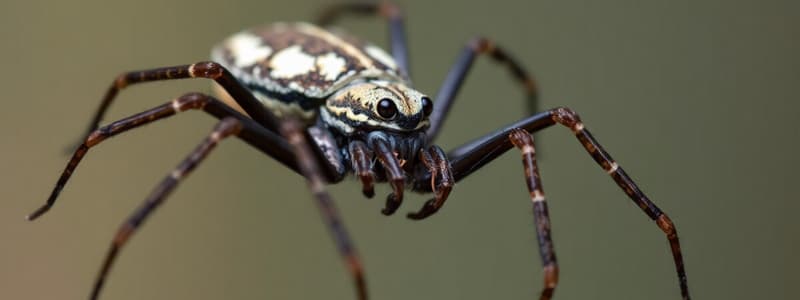Podcast
Questions and Answers
What primary factor distinguishes spiders' feeding frequency from that of humans, as described in the text?
What primary factor distinguishes spiders' feeding frequency from that of humans, as described in the text?
- Spiders' preference for plant-based diets versus humans' meat-based diets.
- Spiders' active hunting strategies requiring constant energy intake versus humans' passive food gathering.
- Spiders' cold-blooded nature allowing them to conserve energy and eat less frequently compared to warm-blooded humans. (correct)
- Spiders' warm-blooded nature requiring daily meals versus humans' cold-blooded nature.
Which of the following best describes the typical diet of spiders, according to the information provided?
Which of the following best describes the typical diet of spiders, according to the information provided?
- Omnivores, with a balanced diet of both plant material and insects, adapting to available food sources.
- Primarily herbivores, consuming various types of plant material and occasionally insects.
- Strictly carnivores, feeding on a variety of living or recently deceased animals, but excluding plants. (correct)
- Detritivores, mainly consuming decaying organic matter and dead insects found in their webs.
What is the main function of spider silk in the context of their eating habits?
What is the main function of spider silk in the context of their eating habits?
- To construct webs for trapping unsuspecting insects and to wrap captured prey. (correct)
- To camouflage spiders from predators while they hunt.
- To digest food externally before consumption, similar to spider vomit.
- To attract prey with its bright colors and sweet scent.
How do spiders typically subdue and begin digesting their prey after capturing it in their web?
How do spiders typically subdue and begin digesting their prey after capturing it in their web?
Which web type is characterized by its round, wheel-like appearance, as mentioned in the description?
Which web type is characterized by its round, wheel-like appearance, as mentioned in the description?
Besides common insects, what larger types of animals might some spiders occasionally prey upon, according to the text?
Besides common insects, what larger types of animals might some spiders occasionally prey upon, according to the text?
What is a 'trapdoor spider's' unique method of catching prey, as described in the text?
What is a 'trapdoor spider's' unique method of catching prey, as described in the text?
What is a key characteristic of the prey that spiders prefer to consume?
What is a key characteristic of the prey that spiders prefer to consume?
Why are spider webs typically difficult for humans to see, increasing their effectiveness in catching insects?
Why are spider webs typically difficult for humans to see, increasing their effectiveness in catching insects?
What happens to the uneaten portion of the spider's prey, based on the information provided?
What happens to the uneaten portion of the spider's prey, based on the information provided?
Flashcards
Cold-blooded Spiders
Cold-blooded Spiders
Spiders are cold-blooded animals, meaning their body temperature changes with the surrounding environment.
Spiders' Main Diet
Spiders' Main Diet
Spiders primarily feed on insects, such as ants, flies, mosquitoes, and bees.
Spiders' Alternative Prey
Spiders' Alternative Prey
Spiders can also consume small animals like birds, frogs, lizards, and centipedes.
Carnivore Spiders
Carnivore Spiders
Signup and view all the flashcards
Spider Silk and Webs
Spider Silk and Webs
Signup and view all the flashcards
Types of Spider Webs
Types of Spider Webs
Signup and view all the flashcards
Trapdoor Spider Strategy
Trapdoor Spider Strategy
Signup and view all the flashcards
Spider's Prey Digestion
Spider's Prey Digestion
Signup and view all the flashcards
Spider's Feeding Method
Spider's Feeding Method
Signup and view all the flashcards
Partial Prey Consumption
Partial Prey Consumption
Signup and view all the flashcards
Study Notes
Spider Eating Habits
- Spiders are carnivores, meaning they only eat meat.
- They primarily consume insects (ants, flies, mosquitoes, bees).
- Some spiders also eat small animals (birds, frogs, lizards, centipedes) and even other spiders.
- Spiders are cold-blooded, so their body temperature changes with the environment.
- Unlike warm-blooded animals, they don't need to eat constantly.
- They generally only consume living or recently killed prey.
- They do not eat plants.
Spider Hunting Methods
- Spiders use webs to catch food.
- Webs are made of silk, a thin, smooth fiber.
- Webs are often difficult to see, allowing for easy capture of insects.
- Web shapes vary, including orb webs (round) and tangle webs.
- Some spiders, like the trapdoor spider, use specialized hunting methods including a trapdoor in the ground.
Digestion
- After catching prey, spiders wrap it in silk (like a mummy).
- They release digestive fluids onto the prey.
- These fluids help break down the food.
- Spiders use their jaws to chew the food.
- They then suck up the liquefied meal.
- They may not consume all parts of the prey (e.g., hard wings or legs).
Studying That Suits You
Use AI to generate personalized quizzes and flashcards to suit your learning preferences.




